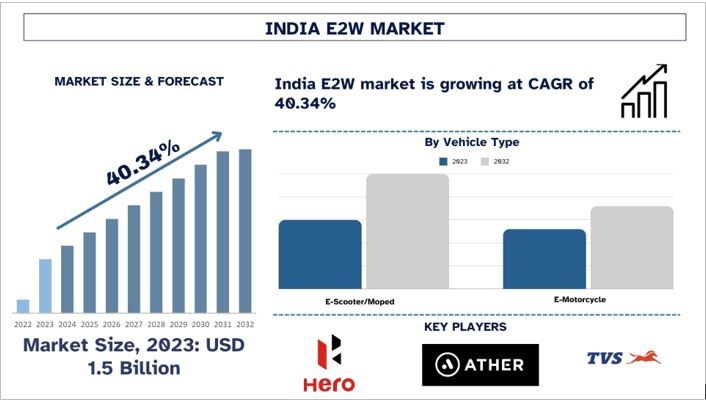- Home
- Chi siamo
- Settore
- Servizi
- Lettura
- Contattaci
Mercato E2W in India: Analisi e Previsioni Attuali (2024-2032)
Enfasi sulla Tipologia di Veicolo (E-Scooter/Moped, E-Motocicletta); Velocità (E2W a Bassa Velocità, E2W ad Alta Velocità); Tecnologia (E2W a Batteria, E2W Plug-in); Utente Finale (Business to Consumer (B2C), Business to Business (B2B)); Regioni
Dimensioni e Previsioni del Mercato E2W in India
Il mercato E2W in India è stato valutato a circa 1,5 miliardi di USD nel 2023 e si prevede che crescerà a un robusto CAGR di circa il 40,34% durante il periodo di previsione (2024-2032) grazie alla crescente urbanizzazione, all'accessibilità economica, all'aumento del reddito disponibile e al passaggio alla mobilità elettrica.
Analisi del Mercato E2W in India
Il mercato dei veicoli elettrici a due ruote in India è destinato a crescere a un ritmo costante a causa del sostegno del governo e della crescente preoccupazione per il riscaldamento globale, e per soddisfare la domanda di mini scooter per l'uso quotidiano. Ad esempio, lo schema FAME offre sussidi, e quindi gli E2W sono diventati più convenienti negli ultimi tempi, mentre aziende come Ola Electric e Hero Electric hanno una quota importante nel mercato degli scooter. Alcuni problemi come punti di ricarica inadeguati e alti costi di acquisizione sono alcune barriere, tuttavia il miglioramento delle batterie e dei servizi di sostituzione delle batterie accelera l'uso. Il mercato E2W avrà un impatto significativo sulla modifica della struttura della mobilità urbana mentre l'India progredisce verso il trasporto sostenibile.
Tendenze del Mercato E2W in India
Questa sezione discute le principali tendenze di mercato che influenzano i segmenti E2W in India, identificate dai nostri esperti di ricerca.
Il tipo di veicolo E-Scooter/Moped trasforma il settore
La crescita degli e-scooter e dei ciclomotori nel mercato indiano dei veicoli elettrici a due ruote è trainata da una combinazione di incentivi governativi che riducono i costi iniziali, l'economicità dei veicoli elettrici in termini di minori spese operative e di manutenzione e la crescente consapevolezza ambientale che spinge verso soluzioni di trasporto più pulite. La congestione urbana aumenta ulteriormente il loro fascino grazie alla loro manovrabilità nel traffico, mentre l'espansione dell'infrastruttura di ricarica e i progressi nella tecnologia delle batterie alleviano l'ansia da autonomia e migliorano l'affidabilità. Questi fattori contribuiscono collettivamente alla crescente popolarità e adozione di e-scooter e ciclomotori in tutta l'India.
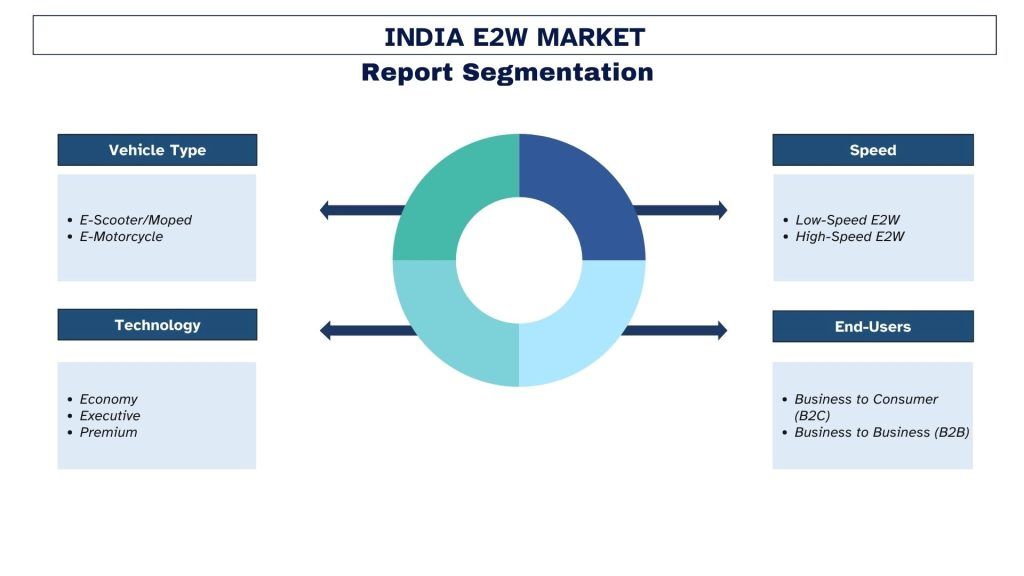
L'India del Nord ha dominato il mercato nel 2023
La crescita del mercato dei veicoli elettrici a due ruote (E2W) nell'India del Nord è alimentata da incentivi e politiche governative che rendono gli E2W più accessibili, dall'aumento dell'inquinamento urbano che guida la domanda di trasporti più puliti e dall'aumento dei prezzi del carburante che evidenziano l'economicità dei veicoli elettrici. Inoltre, il miglioramento delle infrastrutture come le reti di ricarica e le stazioni di sostituzione delle batterie, combinato con l'aumento del reddito disponibile, supporta ulteriormente l'espansione del mercato. Questi fattori contribuiscono collettivamente alla crescente adozione di E2W nell'India del Nord, riflettendo un passaggio verso soluzioni di trasporto più sostenibili ed economicamente efficienti.
Panoramica del Settore E2W in India
E2W in India è competitivo, con diversi attori del mercato indiani e internazionali. I principali attori stanno adottando diverse strategie di crescita per migliorare la loro presenza sul mercato, come partnership, accordi, collaborazioni, lanci di nuovi prodotti, espansioni geografiche e fusioni e acquisizioni. Alcuni dei principali attori operanti nel mercato sono Hero Electric, Okinawa, Ather Energy, Ampere Vehicles, Revolt, PureEV, Ola Electric Mobility, Kinetic Green, Evolet e TVS.
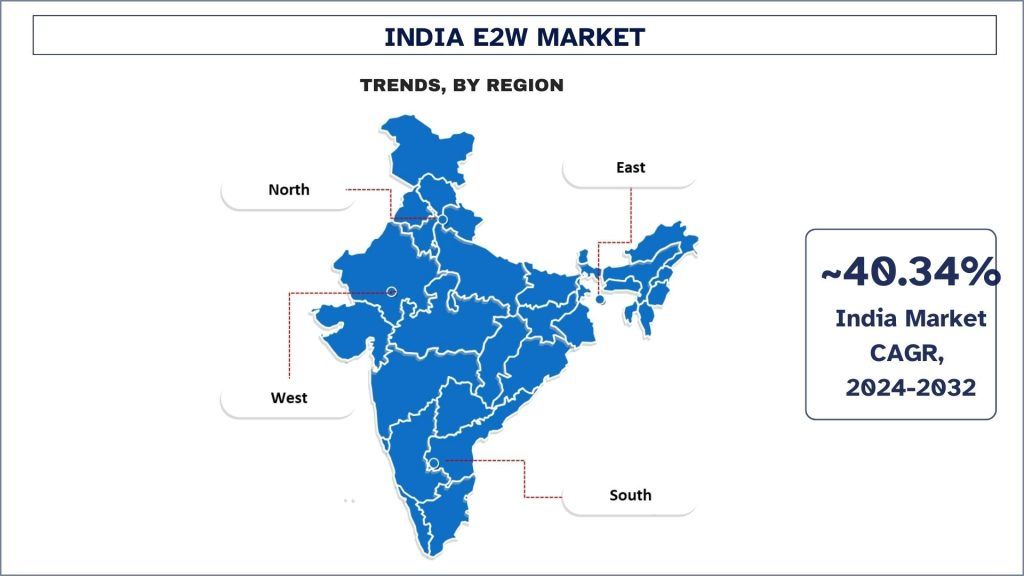
Notizie sul Mercato E2W in India
Ad esempio, nel 2024, il produttore di scooter elettrici Ather Energy ha lanciato una nuova gamma di scooter rivolti al mercato familiare chiamata Rizta.
Ad esempio, Honda Global ha confermato i piani per lanciare una motocicletta elettrica equivalente a 110-125 cc per pendolari in India il prossimo anno. L'annuncio faceva parte della nuova strategia di elettrificazione delle motociclette di Honda Motor Co, che vedrà il produttore investire 3,4 miliardi di dollari entro il 2030 in nuovi prodotti e sviluppo. Il gigante dei veicoli a due ruote ha anche rivisto il suo obiettivo di vendite globali da 3,5 milioni a 4 milioni di motociclette elettriche entro il 2030.
Copertura del Rapporto sul Mercato E2W in India
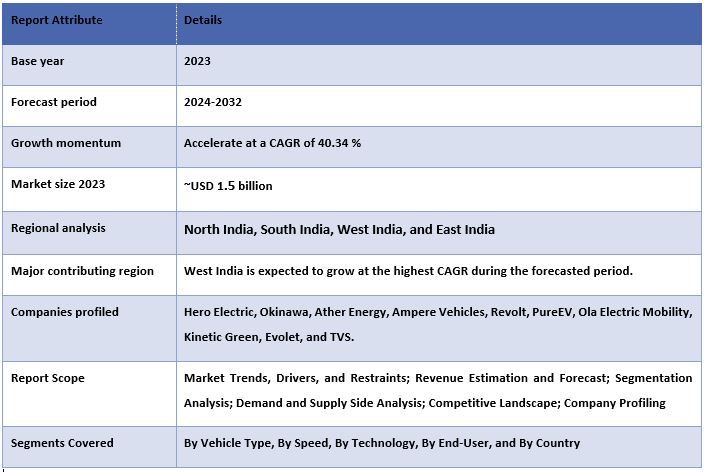
Motivi per acquistare questo rapporto:
- Lo studio include la dimensione del mercato e l'analisi delle previsioni convalidate da esperti chiave del settore autenticati.
- Il rapporto presenta una rapida panoramica delle prestazioni complessive del settore a colpo d'occhio.
- Il rapporto copre un'analisi approfondita dei principali concorrenti del settore con un focus primario sui principali dati finanziari aziendali, sui portafogli di prodotti, sulle strategie di espansione e sugli sviluppi recenti.
- Esame dettagliato dei fattori trainanti, dei vincoli, delle tendenze chiave e delle opportunità prevalenti nel settore.
- Lo studio copre in modo completo il mercato in diversi segmenti.
- Analisi approfondita a livello regionale del settore.
Opzioni di personalizzazione:
E2W in India può essere ulteriormente personalizzato in base alle esigenze o a qualsiasi altro segmento di mercato. Oltre a ciò, UMI capisce che potresti avere le tue esigenze aziendali; quindi, sentiti libero di metterti in contatto con noi per ottenere un rapporto che si adatti completamente alle tue esigenze.
Indice
Metodologia di Ricerca per l'Analisi del Mercato E2W in India (2022-2032)
L'analisi del mercato storico, la stima del mercato attuale e la previsione del mercato futuro del mercato E2W in India sono stati i tre passaggi principali intrapresi per creare e analizzare l'adozione di E2W in India nelle principali regioni. È stata condotta un'esauriente ricerca secondaria per raccogliere i dati storici del mercato e stimare le dimensioni attuali del mercato. In secondo luogo, sono stati presi in considerazione numerosi risultati e ipotesi per convalidare queste intuizioni. Inoltre, sono state condotte ampie interviste primarie con esperti del settore lungo tutta la catena del valore del mercato E2W in India. Dopo l'assunzione e la convalida dei dati di mercato tramite interviste primarie, abbiamo impiegato un approccio top-down/bottom-up per prevedere le dimensioni complete del mercato. Successivamente, sono stati adottati metodi di scomposizione del mercato e di triangolazione dei dati per stimare e analizzare le dimensioni del mercato dei segmenti e dei sottosegmenti del settore. La metodologia dettagliata è spiegata di seguito:
Analisi delle Dimensioni Storiche del Mercato
Fase 1: Studio Approfondito delle Fonti Secondarie:
È stato condotto uno studio secondario dettagliato per ottenere le dimensioni storiche del mercato del mercato E2W in India attraverso fonti interne aziendali comerapporti annuali e rendiconti finanziari, presentazioni delle prestazioni, comunicati stampa, ecc.e fonti esterne tra cuiriviste, notizie e articoli, pubblicazioni governative, pubblicazioni della concorrenza, rapporti di settore, database di terze parti e altre pubblicazioni credibili.
Fase 2: Segmentazione del Mercato:
Dopo aver ottenuto le dimensioni storiche del mercato di E2W in India, abbiamo condotto un'analisi secondaria dettagliata per raccogliere approfondimenti storici sul mercato e la quota per diversi segmenti e sottosegmenti per le principali regioni. I principali segmenti sono inclusi nel rapporto, come tipo di veicolo, velocità, tecnologia, utenti finali e regione. Ulteriori analisi a livello di paese sono state condotte per valutare l'adozione complessiva dei modelli di test in quella regione.
Fase 3: Analisi dei Fattori:
Dopo aver acquisito le dimensioni storiche del mercato di diversi segmenti e sottosegmenti, abbiamo condotto un'analisi dettagliataanalisi dei fattoriper stimare le dimensioni attuali del mercato del mercato E2W in India. Inoltre, abbiamo condotto un'analisi dei fattori utilizzando variabili dipendenti e indipendenti come tipo di veicolo, velocità, tecnologia, utenti finali e regioni E2W in India. È stata condotta un'analisi approfondita degli scenari di domanda e offerta considerando le principali partnership, fusioni e acquisizioni, l'espansione del business e i lanci di prodotti nel settore del mercato E2W in India in tutto il mondo.
Stima e Previsione delle Dimensioni Attuali del Mercato
Dimensionamento del Mercato Attuale:Sulla base di approfondimenti utili dai tre passaggi precedenti, siamo arrivati alle dimensioni attuali del mercato, ai principali attori del mercato E2W in India e alle quote di mercato dei segmenti. Tutte le necessarie quote percentuali, le suddivisioni e le scomposizioni del mercato sono state determinate utilizzando l'approccio secondario sopra menzionato e sono state verificate tramite interviste primarie.
Stima e Previsione:Per la stima e la previsione del mercato, sono stati assegnati pesi a diversi fattori, inclusi i fattori trainanti e le tendenze, i vincoli e le opportunità disponibili per gli stakeholder. Dopo aver analizzato questi fattori, sono state applicate tecniche di previsione pertinenti, ad esempio, l'approccio top-down/bottom-up, per arrivare alle previsioni di mercato per il 2032 per diversi segmenti e sottosegmenti nei principali mercati. La metodologia di ricerca adottata per stimare le dimensioni del mercato comprende:
- Le dimensioni del mercato del settore, in termini di fatturato (USD) e il tasso di adozione degli E2W in India nei principali mercati a livello nazionale
- Tutte le quote percentuali, le suddivisioni e le ripartizioni dei segmenti e dei sotto-segmenti di mercato
- Attori chiave nel mercato degli E2W in India in termini di prodotti offerti. Inoltre, le strategie di crescita adottate da questi attori per competere nel mercato in rapida crescita
Validazione delle dimensioni e della quota di mercato
Ricerca primaria:Sono stati condotti colloqui approfonditi con i Key Opinion Leader (KOL), inclusi i dirigenti di alto livello (CXO/VP, Responsabile delle vendite, Responsabile marketing, Responsabile operativo, Responsabile regionale, Responsabile nazionale, ecc.) in tutte le principali regioni. I risultati della ricerca primaria sono stati quindi riassunti ed è stata eseguita un'analisi statistica per dimostrare l'ipotesi dichiarata. Gli input della ricerca primaria sono stati consolidati con i risultati secondari, trasformando quindi le informazioni in approfondimenti utili.
Suddivisione dei partecipanti primari in diverse regioni
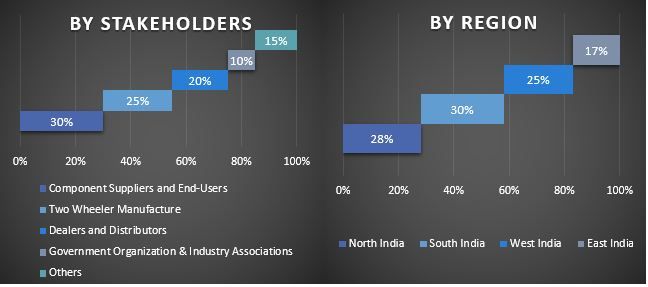
Ingegneria del mercato
La tecnica di triangolazione dei dati è stata impiegata per completare la stima complessiva del mercato e per arrivare a numeri statistici precisi per ogni segmento e sotto-segmento degli E2W in India. I dati sono stati suddivisi in diversi segmenti e sotto-segmenti dopo aver studiato vari parametri e tendenze nel tipo di veicolo, velocità, tecnologia, utenti finali e regioni del mercato degli E2W in India.
L'obiettivo principale dello studio di mercato degli E2W in India
Le attuali e future tendenze del mercato degli E2W in India sono state individuate nello studio. Gli investitori possono ottenere informazioni strategiche per basare la propria discrezionalità sugli investimenti sull'analisi qualitativa e quantitativa eseguita nello studio. Le attuali e future tendenze del mercato hanno determinato l'attrattiva complessiva del mercato a livello regionale, fornendo una piattaforma per il partecipante industriale per sfruttare il mercato inesplorato per beneficiare del vantaggio del primo ad arrivare. Altri obiettivi quantitativi degli studi includono:
- Analizzare le attuali e previste dimensioni del mercato degli E2W in India in termini di valore (USD). Analizzare anche le attuali e previste dimensioni del mercato dei diversi segmenti e sotto-segmenti.
- I segmenti nello studio includono le aree di tipo di veicolo, velocità, tecnologia, utenti finali e regioni.
- Definire e analizzare il quadro normativo per gli E2W in India
- Analizzare la catena del valore coinvolta con la presenza di vari intermediari, insieme all'analisi dei comportamenti dei clienti e dei concorrenti del settore.
- Analizzare le attuali e previste dimensioni del mercato degli E2W in India per le principali regioni.
- Le principali regioni studiate nel rapporto includono India settentrionale, India occidentale, India meridionale e India orientale
- Profili aziendali del mercato degli E2W in India e le strategie di crescita adottate dagli operatori di mercato per sostenersi nel mercato in rapida crescita.
- Analisi approfondita a livello regionale del settore
Domande frequenti FAQ
Q1: Qual è la dimensione attuale e il potenziale di crescita di India E2W?
Q2: Quali sono i fattori trainanti della crescita di India E2W?
Q3: Quale segmento detiene la quota maggiore di India E2W per tipologia di veicolo?
Q4: Quali sono le tecnologie e le tendenze emergenti in India E2W?
Q5: Quale regione dominerà il mercato India E2W?
Correlati Report
I clienti che hanno acquistato questo articolo hanno acquistato anche

